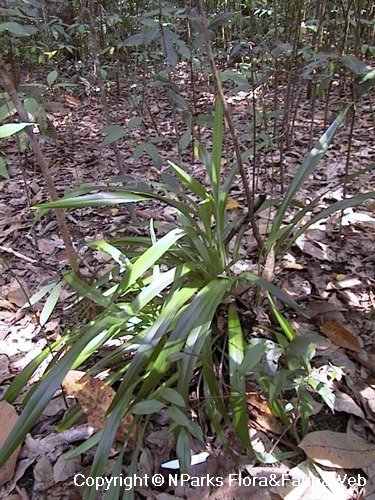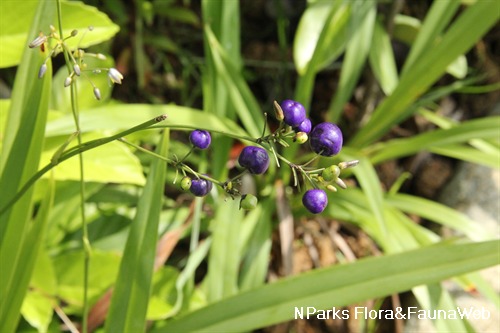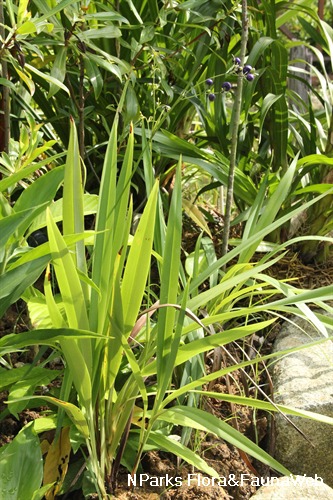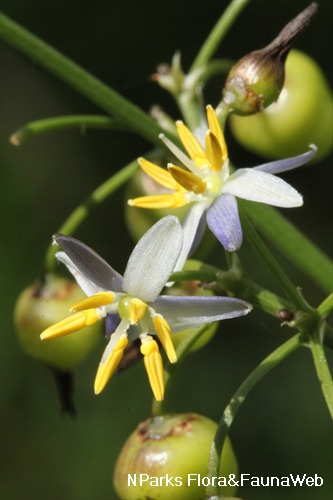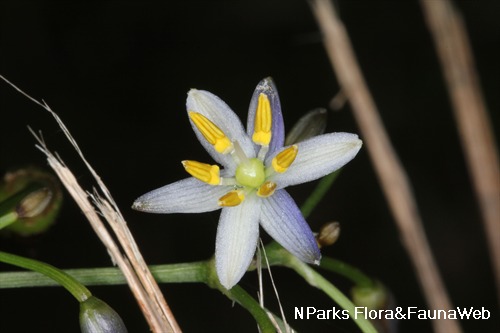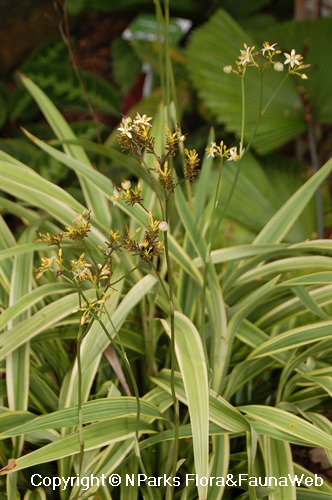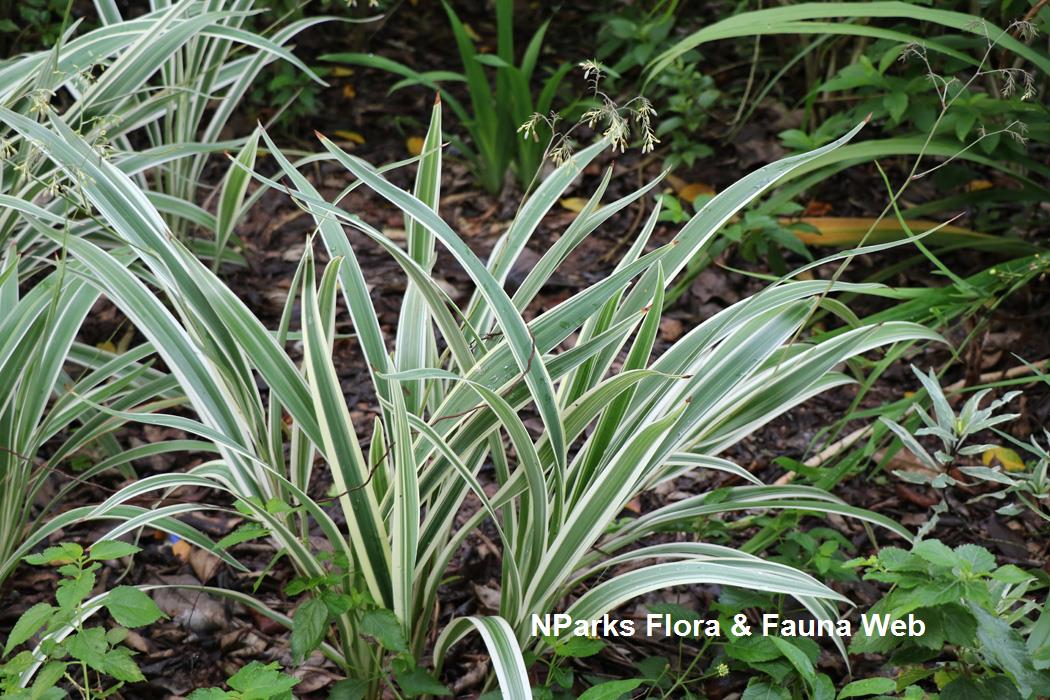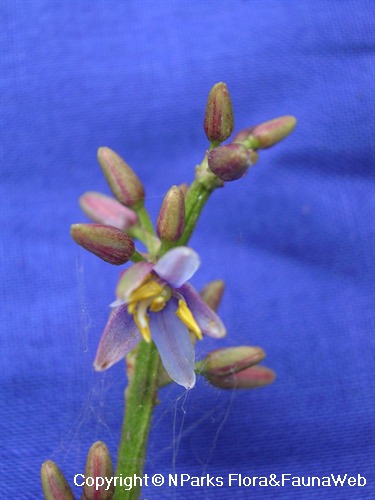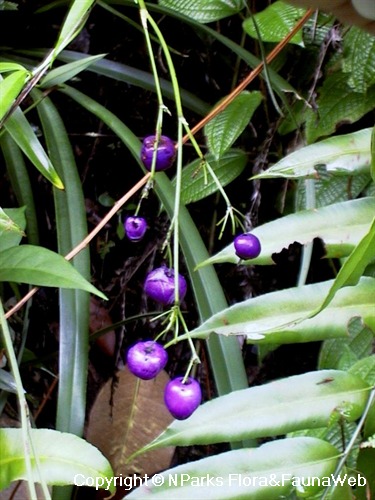
Back
Dianella ensifolia (L.) Redouté
| Family Name: | Asphodelaceae |
| Synonyms: | Dracaena ensifolia L., Cordyline ensifolia (L.) Planch. |
| Common Name: | Cerulean Flax-lily, Common Dianella, Umbrella Dracaena, Siak-siak, 山菅兰 |
Dianella ensifolia, also known as Cerulean Flax-lily, is a native herbaceous plant that can be commonly found in the forests and rocky shores of Singapore. It forms grassy clumps of long sword-shaped leaves and bears flower spikes of white, yellow or light purplish blue star-shaped flowers, followed by glossy bluish purple berries. The striking fruit are thought to be toxic.
Name
Classifications and Characteristics
| Plant Division | Angiosperms (Flowering Seed Plants) (Monocotyledon) |
|---|---|
| Plant Growth Form | Herbaceous Plant |
| Lifespan (in Singapore) | Perennial |
| Mode of Nutrition | Autotrophic |
| Plant Shape | Shrubby |
| Maximum Height | 1.2 m to 1.8 m |
Biogeography
| Native Distribution | Madagascar, India, Sri Lanka, Nepal, Bangladesh, Bhutan, southern China, Taiwan, Japan, Myanmar, Laos, Vietnam, Cambodia, Thailand, Malaysia, Singapore, Philippines, Indonesia, eastern Australia, & the Pacific Islands |
|---|---|
| Native Habitat | Terrestrial (Primary Rainforest, Secondary Rainforest, Grassland / Savannah/ Scrubland) |
| Preferred Climate Zone | Tropical |
| Local Conservation Status | Native to Singapore (Least Concern (LC)) |
Description and Ethnobotany
| Growth Form | It is a perennial herbaceous plant with creeping, much-branched rhizome (horizontal stem growing at ground level) from which arise at regular intervals, roots and up to 1.8 m-tall clumping, flowering stems. |
|---|---|
| Foliage | Its flowering stem bears two rows of alternate, stalkless leaves. The leaves have leathery leaf blades that are sword-shaped, tapered at both ends, and 30–80 x 1–2.5 (–3.0) cm, with sheaths at their bases. |
| Flowers | Its flowering shoot is a panicle up to 0.4 m long. It bears flowers up to 0.6 cm wide, with white or bluish-white petals and sepals, and bright yellow-orange anthers. The flowers open in the afternoon. |
| Fruit | Its ripe fruits are round, shiny, deep blue berries (4 - 6 mm wide) and contain 3–6 seeds. Its seeds are ovoid, 3–5 mm long, shiny, and black. |
| Habitat | It can be found in open grasslands to primary forests from 0 - 3000 m above sea level. In Singapore, it occurs in Kent Ridge, Labrador Park, St John’s Island, Pulau Ubin (Chek Jawa), and Pulau Tekong, as well as many other forest sites. |
| Associated Fauna | Its flowers are insect-pollinated, and its fruits are eaten by birds. |
| Cultivation | It is propagated by seed or splitting clumps. |
| Etymology | The genus Dianella is named after Diana, a goddess of Roman mythology. The specific epithet ensifolia is Latin for "sword-shaped leaf", referring to the shape of the leaf blades of the species. |
| Ethnobotanical Uses | Medicinal: The stems, leaves, fruits
and roots are used medicinally in the treatment for various ailments and
diseases. Others: The rhizomes and roots are used in cosmetics and perfume, while the boiled leaves are used to make incense. A mixture of the pounded rhizome and rice, is roasted and used as a rodent poison. |
Landscaping Features
| Landscaping | This herb is suitable for parks and gardens, and may be able to tolerate roadside conditions. It is grown as for its lush foliage, and attractive flowers, and shiny, deep blue fruits that are most unusual for the local flora. It is tolerant of a wide range of conditions so should be able to grow from coastal to inland situations. |
|---|---|
| Desirable Plant Features | Ornamental Foliage, Ornamental Fruits |
| Landscape Uses | General, Parks & Gardens, Small Gardens, Interiorscape/ Indoor Plant, Container Planting |
Fauna, Pollination and Dispersal
| Fauna Pollination Dispersal Associated Fauna | Bird-Attracting (Fruits) |
|---|---|
| Pollination Method(s) | Biotic (Fauna) |
| Seed or Spore Dispersal | Biotic (Fauna) |
Plant Care and Propagation
| Light Preference | Semi-Shade, Full Sun |
|---|---|
| Water Preference | Moderate Water |
| Plant Growth Rate | Moderate |
| Rootzone Tolerance | Moist Soils, Well-Drained Soils, Fertile Loamy Soils, Acidic (low pH) Soils, Easy to Grow |
| Propagation Method | Seed, Division |
Foliar
| Foliage Retention | Evergreen |
|---|---|
| Mature Foliage Colour(s) | Green |
| Mature Foliage Texture(s) | Leathery, Smooth, Glossy / Shiny |
| Foliar Type | Simple / Unifoliate |
| Foliar Arrangement Along Stem | Alternate |
| Foliar Attachment to Stem | Sessile |
| Foliar Shape(s) | Non-Palm Foliage (Linear, Lanceolate) |
| Foliar Venation | Parallel |
| Foliar Margin | Serrulate |
| Typical Foliar Area | Mesophyll ( 45cm2 - 182.25 cm2 ), Macrophyll ( 182.25cm2 - 1640.25 cm2 ) |
| Leaf Area Index (LAI) for Green Plot Ratio | 3.5 (Shrub & Groundcover - Monocot) |
| Typical Foliar Size | 30 cm to 80 cm |
Non - Foliar and Storage
| Root Type | Underground (Fibrous Root) |
|---|---|
| Specialised Storage Organ(s) | Underground (Rhizome) |
Floral (Angiosperm)
| Flower & Plant Sexuality | Bisexual Flowers |
| Flower Colour(s) | Purple, Blue, White |
|---|---|
| Flower Grouping | Cluster / Inflorescence |
Fruit, Seed and Spore
| Mature Fruit Colour(s) | Blue, Purple |
|---|---|
| Fruit Type | Fleshy Fruit , Non-Accessory Fruit |
References
| References | Thin, N.N. & Thanh, N.T., (2001). Dianella ensifolia (L.) DC.. In: van Valkenburg, J.L.C.H. and Bunyapraphatsara, N. (Editors): Plant Resources of South-East Asia No 12(2): Medicinal and poisonous plants 2. PROSEA Foundation, Bogor, Indonesia. |
|---|
Image Repository
Others
| Master ID | 634 |
|---|---|
| Species ID | 5194 |
| Flora Disclaimer | The information in this website has been compiled from reliable sources, such as reference works on medicinal plants. It is not a substitute for medical advice or treatment and NParks does not purport to provide any medical advice. Readers should always consult his/her physician before using or consuming a plant for medicinal purposes. |

